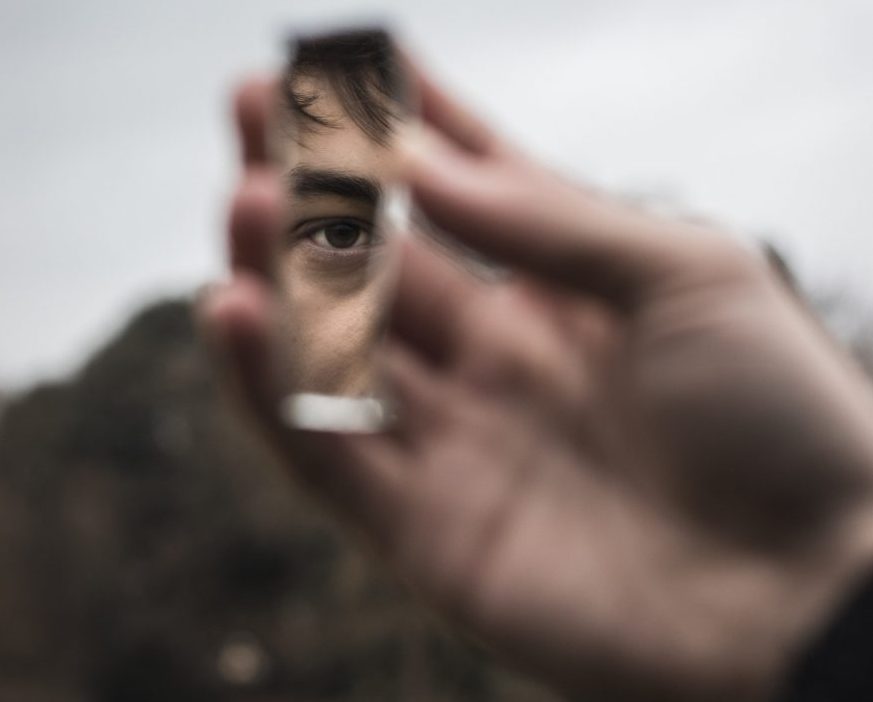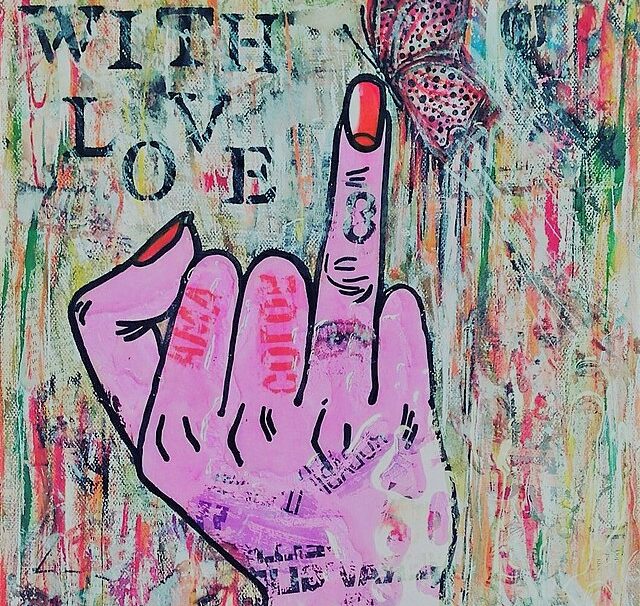interviews
Genderqueer Short Stories About the Ways We Mythologize Our Identities
Morgan Thomas, author of "Manywhere," on queer joy and what we inherit from our ancestors

A nonbinary teenager on their way home from an eating -disorder treatment center who tries to convince a stranger she is not a vampire, an aspiring fashion designer/dry-cleaning worker who develops an obsession with a customer, a community of people with Hansen’s disease that welcome and attempt to coexist with a newly arrived group of people displaced by natural disaster—these are only some of the inimitable characters Morgan Thomas follows in their stunning debut collection, Manywhere. These characters move through and navigate the complexities of their communities with immense precision and stayed with me long after the first time I read these stories.
Manywhere interrogates the complications of constructing a personal narrative, especially those faced by queer and genderqueer people—How does our relationship to others affect our own identity-making? How have our own identities and history benefitted from the marginalization of others? What have we inherited from our ancestors, and what do we owe to them in how we live our lives?
I spoke with Thomas over Zoom about using historical records in fiction, navigating inherited narratives, and the relationships people build not only with each other but with their environments.
Matthew Mastricova: There’s a line in that story that served as a lodestar for me in reading this collection. It’s when the narrator Taylor says, “But I haven’t come looking for family. I’ve come to meet you, lightning man.” It signaled to me a repeating theme throughout this collection: the tension between inherited narratives and self-determined narratives. I was wondering if you could talk a bit more about how your stories manifest or are guided by that tension.
Morgan Thomas: All of the driving impulse behind the collection as a whole was a search for ancestry and lineage. It began as a search for a specific type of queer and genderqueer ancestry. I was in a space where I was trying to understand my own identities—my own gender, my own sexuality. I felt like I lacked language and models for identity on both of those axes, and I wasn’t really in a place where I could look around immediate contemporary environment for those models, and so I found myself increasingly looking toward history. And as I looked at historical figures and models, I realized both that they were abundant and also that those queer and genderqueer ancestors were really complicated. I think that Manywhere, is in large part, my attempt to wrestle with those complicated histories. By complicated, I mean that as a white settler who is genderqueer, it’s appropriative for me to claim as an ancestor an indigenous historical figure who had a gender identity that didn’t conform to settler colonial ideas of a binary gender. It’s appropriative for me to claim a Black gender-diverse individual in history, so I’m working with white lineages that are queer and genderqueer, and that means that these people are also often, I think actually without exception, complicit in projects of settler colonization and structures of racism. It’s wrestling with these lineages that I had searched for and these stories that I wanted to claim said something about myself, but together with those I was also inheriting more complicated and complex legacies.
MM: As we’re talking about looking through the archives for historical models of queerness, I was wondering how you navigated using the archive when so many of these historical figures are not identified as queer. How does an author responsibly incorporate those models and narratives into their work?
MT: That was something I thought a lot about as I was writing. I think partially it’s why the collection has to be fiction. There are a lot of gaps in historical record. So, for example, the story “The Daring Life of Philippa Cook” is based on the life of Thomas/ine Hall, but all I know of Hall’s life is the earliest piece of it, up until the trial transcripts that served as the seed of that story. After that there’s nothing. In fiction, I’m able to write into and extend that story and that life. I also think that fiction allows me to avoid saying anything definite about the gender or sexuality of the historical figures that the stories are thinking about and writing toward. For instance, I deliberately used “you and I” in “Taylor Johnson’s Lightning Man” instead of any pronouns that would inscribe gender or suggest that I had a firm sense of what pronouns Frank Woodhull would have used if Frank Woodhull existed in 2021, and that was really important to me. I don’t want to take contemporary notions of what it is to be queer or genderqueer and force those upon a historical figure or insist that those applied equally a century ago, or four centuries ago.
I like the idea that the ways that we think about queer and genderqueer identities are fluid throughout time. That feels really hopeful to me, because I think it suggests the possibility for different ideas of queerness and genderqueerness in the future.
MM: So you have these stories that are based that are based on archival figures, and then you have “Taylor Johnson’s Lightning Man” where it’s explicitly Frank Woodhull. There is archival information about that person explicitly in the text. Is the Woodhull that Taylor talks to in the story the historical Woodhull or a characterized version of that person?
MT: I want the story to have space for both. I mean, clearly I think it’s fictional and that’s the benefit again of being able to have this narrator who, I think, is seeking something from Frank Woodhull, and so is creating a Frank Woodhull that satisfies their own needs and desires in that moment. Also, much of the dialogue spoken by Woodhull at the end of that story is taken from newspaper articles from the time and from interviews that Frank Woodhull actually gave. So it’s a blend of a Frank Woodhull that Taylor Johnson has created for themself and of Frank Woodhull in the past, and I think that blend is also filtered itself through Taylor Johnson’s experience.
I don’t want to take contemporary notions of what it is to be queer or genderqueer and force those upon a historical figure or insist that those applied equally centuries ago.
That’s where I think fiction can get really interesting, because then there’s a second layer where there’s this blended character who is a Frank Woodhull historical and non-historical character and then there’s also Taylor Johnson, who has created that character, and then there is myself, the writer, who has created the character Taylor Johnson who created the character Frank Woodhull, and when I start to see that telescoping process of creation and narration, that’s when I get really interested in story and what stories mean to us, why we create the stories that we do and what they say about us.
MM: Do you think that process of blending fictionalization and research is also similar to how we relate to the people who raise us?
MT: Oh, I don’t know, possibly. I think all of all of the stories in Manywhere, both those that deal more with folks seeking ancestors that they are not descended from by blood and those that deal more with inheritance on the level of like grandparents and parents, are interested in constructed narratives and in the flimsiness and fluidity of the stories that we tell about our ancestors, whether we have sought and chosen those ancestors or whether we are descended from them by blood.
I’m not sure, to be honest with you, whether the process itself, though, is the same. This makes me think again about being a settler and a white writer from the South and the fact that so much of what I inherit from the ancestors from whom I am descended by blood are legacies of Southern colonization and slavery and racial violence. In that regard specifically, the responsibility feels different to me. It feels somehow less about constructing narratives and filling in gaps and more about holding myself accountable for the narratives and beliefs that I’ve inherited. Thinking critically about those and trying to dismantle any aspect of those inherited narratives that is inherently racist or white supremacist or colonial in nature.
MM: Something that I kept thinking about while reading your book was the relationship between the healthcare industry and marginalized individuals, especially during “That Drowning Place” and “The Expectation of Cooper Hill.” I was hoping you could talk a bit more about that relationship and how it manifests in your stories.
MT: Manywhere is deeply concerned with our relationships with our environment and with the health effects of the places where we live, whether that be the fracking in “Surrogate” or how in “That Drowning Place” we’re seeing individuals have to leave their homes because of rising sea levels and then sort of come up against other communities.
So much of what I inherit from the ancestors from whom I am descended by blood are legacies of Southern colonization and slavery and racial violence.
Manywhere is really concerned with the body, and when I think about health care, I just know that current healthcare systems are not designed for queer or genderqueer people, and I think about myself, my partner, the many people in my community who have had to act as self-advocates. They’ve had to figure out how to navigate systems that are deliberately attempting to inhibit their access to care that they need from gender-affirming care to lifesaving care. I think that that is not something that I deliberately included in the stories, but I think that it’s a thread that is present.
MM: You’ve written about your history of attempting to write genderqueer embodiment and grappling with what it means to be a white genderqueer person. I was wondering if your relationship to that has changed it all in the process of writing this collection, because the physicality of these characters was one of the things I really loved.
MT: I think that what that essay highlights is how indebted I am to the writers who have come before me. I think about Rivers Solomon’s An Unkindness of Ghosts, which I think is one of several books that taught me how to write genderqueer embodiment. I think, also, about Freshwater by Akwaeke Emezi. I think about Joshua Whitehead’s work. I think about Abbey Mei Otis and I think about Billy Ray Belcourt’s memoir, which came out much more recently, but which has been a real guiding light for me. These are permission-giving books: they expand the ways that I feel able to think and write about both gender and sexuality.
I think it answer your question, yes, my ability to think through on the page and to write genderqueer characters who are fully realized as physical beings in the world has shifted since I began Manywhere. I understand now better how to inscribe bodies and complex relationships to bodies for my characters, and I think that that’s in large part due to the foundational and courageous work of those other writers, and I’m really grateful to them.
MM: You spoke about how humanity’s relationship to the environment was a major factor in Manywhere. I love the ways in which queerness and the environment were put into conversation here. There’s two questions I want to ask—One is what led you to explore this relationship, and two, what are the types of relationships you hope people see in this collection?
MT: One thing that is important to me as a writer when I’m thinking about ecology and environments is to remember that ecology is, just at its most basic definition, a word that we use to describe how we relate to each other as beings, and also how we relate to our physical environments. So it’s important to me that when I think about Manywhere as a book that’s engaging with ecology or a book that’s engaging with the environment, that’s different, I think, from saying that it’s a book that’s engaging with “nature”, as though it’s something that’s different from the places where people are living or congregating or from cities.
The current healthcare systems are not designed for queer or genderqueer people.
When you’re asking like what relationships I’m hoping people see in the work, I’m hoping that people recognize that ecological and environmental relationships are happening everywhere and anywhere that people are interacting with one another and the people are interacting with their environment. I think there are ways in which the study of ecology and my own approaches to and study of queerness are very similar in that they both feel like they’re centered on relationships, and I’m trying to describe, understand, and expand the ways that we’re thinking about about relationships.
I hope that people see in Manywhere a few threads of environmental lineage. “Surrogates,” I think, is the clearest example where the embodiment is used in part to explore the effects of fracking on the health of people who give birth and infants, and it was sparked by an article I read in Rolling Stone about a midwife in Vernal, Utah, who had been speaking out about the health effects of fracking on infants in that town and received a lot of pressure from other people in the town as a result of those comments. So I was thinking a lot about the often binary and transphobic big ways we think about like childbirth and parenthood. I was also thinking about the ways that individuals and towns that are right up against industries that are polluting engage with those industries. And I was also thinking about, within that story, the many different ways that we can have intimacy with other people. So Brighton is in a sort of monogamous and to-some-extent heteronormative relationship with her husband and also has this different sort of intimacy with the other surrogates and with Doc Lacher. I think all of those questions and all of those relationships are ecological in nature, and in that regard, I think that Manywhere is a deeply ecological book.
MM: There’s a healthy tinge of fabulism throughout Manywhere. I’m thinking particularly of “Manywhere” where we have the other daughter and “The Expectation of Cooper Hill” with Sylvia falling into the bag. How did you come to fabulism as a storytelling tool, specifically in this deeply ecological and embodied collection?
MT: There are two things that are coming to mind, for me. The first is that, again, as a writer interested specifically in thinking about and writing into historical gaps that have to do with queer and gender-diverse ancestors, speculation feels like a necessary tool, and fiction feels like it offers a lot more space for speculation than, say, nonfiction. I think there’s a natural logical leap from that type of speculation that is necessary to fill gaps in historical records to what we think of now as speculative fiction. There’s something really interesting to me as a writer about blending deeply researched fiction with elements that are fabulous or speculative in nature.
I think the other thing that comes to mind for me is that when I have tried to approach queer joy on the pages as an author, or when I think about the way that the narrator of Manywhere at the end of that story feels this ephemeral sense of liberation from their father, and of joy, I realized pretty early on that I didn’t have in my life at the time many actual models of that type of queer or genderqueer joy, and I think that attempting to end up at that space required these leaps and moments of invention which I think also lend themselves directly to the fabulous elements that you see in the stories.
MM: I love that. I think queer joy is something that is largely missing from received cultural narratives surrounding genderqueerness and queerness in general. Which is another thing I loved about this collection, I felt like it inverted that received narrative of like, “Oh, when a child is queer they’re rejected by their families,” but so many queer people actively seek out joy and liberation. Was this a relationship you aimed to capture?
MT: I think probably the most honest answer is that often on the page I’m writing towards the place that I’m hoping to get in my life, and I think that place is not always a place of joy. It might be that space of full accountability, or it might be a space of deeper understanding of myself and my identities, and it also might be a space of joy. I think that I write narratives that I want to read and maybe aspects of the emotional tones of Manywhere, especially around joy, are things that I was writing into because maybe I had not, when I was writing the stories, experienced them and I wanted to.









